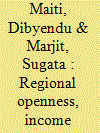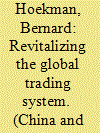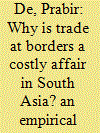| Srl | Item |
| 1 |
ID:
139485


|
|
|
|
|
| Summary/Abstract |
As a country progressively engages in international trade, its factors of production increasingly enter into the export sector, where their return is higher compared to the import-competing sector. At the regional level too, those states which can attune their production structure to international demands earn more from trade than other states, and also grow at a faster rate. A regional openness index has been reconstructed by combining the export and import intensities of the states, ranks of correlation of state production shares, respectively, with tradable production share as suitable weights at the state level. The index is highly influenced by the institutional variation across states in a federal setting. The per capita net state domestic products have been growing in all major states in India during the period 1980–2009, but at different rates, and one of the detrimental factors for this has been regional openness.
|
|
|
|
|
|
|
|
|
|
|
|
|
|
|
|
| 2 |
ID:
146696


|
|
|
|
|
| Summary/Abstract |
Since 2008, G20 leaders have repeatedly committed themselves not to resort to protectionism and to conclude WTO negotiations expeditiously. The jury is out on the extent to which they have lived up to the first promise; they have failed to deliver the second. Anemic global trade growth rates since 2010 imply that trade has not been a driver of much-needed economic dynamism. This paper argues that the G20 should pursue a more ambitious trade agenda and that there is much that greater leadership by the G20 could do to reinvigorate the trading system. A first step would be to commit to concrete actions that can be implemented by individual governments on a concerted basis and that center on reducing trade costs and improving access to services for firms. The Chinese presidency should also seek to have the G20 commit to more effective monitoring and analysis of trade policy broadly defined (including subsidies and investment incentives) and the impact of the many preferential trade agreements involving China, the EU and the USA, the world's largest trading powers.
|
|
|
|
|
|
|
|
|
|
|
|
|
|
|
|
| 3 |
ID:
175351


|
|
|
|
|
| Summary/Abstract |
Higher trade costs in developing countries have received enormous attention during the recent past. In this context, it is imperative to revisit the factors contributing to such higher trade costs. This article attempts to explore the major determinants of trade costs conceptually and empirically. Further, the study endeavours to solve the puzzle of higher trade costs in the South Asian perspective. Using panel data of 93 countries from 2007 to 2015, the study tends to uncover major determinants of trade costs between South Asian countries and their two proximate regional blocks, namely Asia-Pacific Economic Cooperation (APEC) and Association of Southeast Asian Nations (ASEAN). In estimating the model, the study prefers to use fixed-effect estimation technique, owing to the results of statistical tests carried out to choose the most appropriate model for the estimation. The findings of the study reveal that trade facilitation, political corruption and financial development affect intra-regional trade costs of South Asia significantly. Trade facilitation influences trade costs between South Asia and ASEAN. Moreover, trade facilitation and financial development affect trade costs between South Asia and APEC. The diagnoses of South Asian intra and inter-regional trade costs can push forward ongoing efforts at unlocking the potential of regional integration as well as global integration of the region.
|
|
|
|
|
|
|
|
|
|
|
|
|
|
|
|
| 4 |
ID:
108920


|
|
|
|
|
| Publication |
2011.
|
| Summary/Abstract |
Through the agreement on the South Asian Free Trade Area (SAFTA), South Asian countries are now looking towards deeper integration of the region. Nevertheless, South Asia is far from realising its full potential. The econometric evidence provided in this article strengthens the existing linkage of trade costs, transit and trade flows; the higher the transaction costs between each pair of trade partners, the less they trade. The analysis given in this article shows that improved trade facilitation would enhance regional trade very much the same way tariff liberalisation does. This article also suggests that an important means of promoting regional trade could be improved trade facilitation, which will not only enhance regional trade but will also strengthen the trade capacity of the landlocked countries.
|
|
|
|
|
|
|
|
|
|
|
|
|
|
|
|